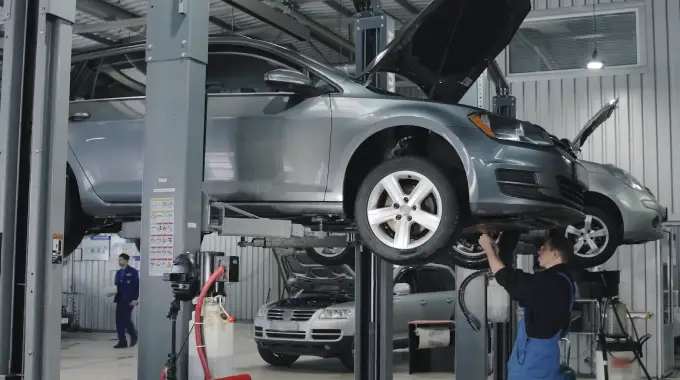Last Updated on March 30, 2023
Vehicle lifts are a piece of necessary and standard equipment in many shops, garages, and other workspaces. They support heavy vehicles and allow mechanics to work on them quickly and safely. To ensure the safety of the operators, vehicle lifts must be inspected regularly.
According to certified lift inspection ANSI/ALI ALOIM:2020, vehicle lifts should be inspected at least once a year or more often as needed based on manufacturer instructions. Regular inspection of vehicle lifts is an important part of maintaining workplace safety and ensuring that these types of equipment function correctly.
Today we will discuss the importance of inspecting vehicle lifts and outline the inspection types for adequately doing so. Vehicle owners and operators should understand the importance of regular vehicle lift inspections and take the necessary steps to ensure their safety. So continue reading.
How Often Should Vehicle Lifts be Inspected: Why Should You?
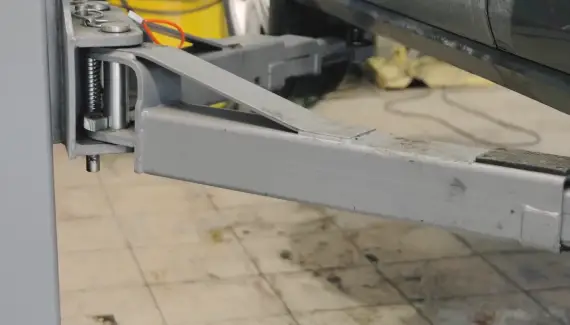
Regularly inspecting your vehicle lifts is one of the most important ways to ensure safety and maintain optimal performance. Here are some of the top reasons why regular inspections are necessary for your automotive lifts:
Operator Safety
Lift operator safety should be the first priority when using or maintaining any vehicle lift system. Regular inspections can identify potential hazards that can lead to accidents or injuries, such as excessive corrosion, uneven surfaces, loose or missing hardware, and worn-out parts.
Aside from that, inspections may uncover deficiencies in the overall design or structure that can lead to serious injury or death if left unchecked. Regular inspections will help ensure your equipment operates safely and reliably, so it’s important to have them carried out by qualified professionals.
Meeting Legal Requirements
In many countries worldwide, specific regulations concerning vehicle lifts must be adhered to to remain compliant with the law. These laws typically specify how often these systems must be inspected to be safe for use, and failure to follow these regulations can lead to penalties for non-compliance.
As such, regular inspections are essential to meeting legal requirements and staying on top of any changes in regulations that might affect your business operations.
Equipment Longevity
Regularly inspecting your vehicle lifts helps identify problems before they become major issues that could take longer and cost more money to repair or replace. Inspections help you spot worn-out parts before they fail, so you don’t lose customers or employees due to costly breakdowns.
Furthermore, regular inspections will alert you when maintenance needs to be done so you can keep your equipment running at peak performance for as long as possible.
Maintaining Optimal Performance
By regularly inspecting your vehicle lifts with an Automotive Lift Institute(ALI) certified inspector, you can ensure they’re running smoothly, so you don’t have to worry about breakdowns or malfunctions.
This also allows you to adjust settings according to the manufacturer’s recommendations or optimize operational procedures, which helps maximize efficiency and minimize costs associated with ongoing maintenance demands over time.
Working Liability
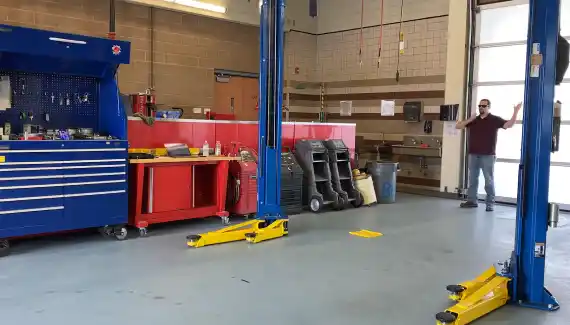
Inspecting vehicle lifts regularly helps ensure that they are working properly and reduce the chances of any liabilities arising due to malfunction or improper usage of such equipment.
Regular inspections allow operators to identify potential problems before they become more serious, thus reducing the likelihood of an accident. Furthermore, regular inspections can help reduce downtime while ensuring a safe working environment for all lift personnel.
Preventive Maintenance
Preventive maintenance is essential for prolonging the life of your vehicle lifts and ensuring their safety and stability. The regular inspection identifies potential problems before they become serious, saving money in repairs and replacement costs.
Moreover, regular wear-and-tear issues can be identified early on by having a professional check on the lifts. This allows you to take necessary corrective actions before these become serious issues requiring costly repair or replacement work.
Thus performing preventive maintenance through regular inspection is an essential step towards extending the lifespan of your vehicle lifts while providing better safety assurance when using them.
Protecting Investments
Your investment in vehicle lifts should be protected with regular inspection and maintenance; this allows you to detect any malfunction or defect in its early stages, preventing unnecessary costs due to repairs or replacements.
Professional technicians can identify parts that need replacing or repairing and recommend appropriate cleaning procedures to help maintain optimal performance. This helps save money from replacing broken parts due to failure from lack of proper care and maintenance in its earlier stages.
Customer Satisfaction
Vehicle lift inspections don’t just provide advantages for keeping up with maintenance but also give customers peace of mind when using them. Customers feel more secure knowing that their equipment has been inspected regularly by an experienced vehicle ALI-certified lift inspector.
By conducting professional lift inspections regularly, you can also ensure that your investment hasn’t gone to waste since every component has been thoroughly checked.
What are the Types of Vehicle Lift Inspections?

Vehicle lifts may require different inspections, including daily, monthly, and yearly inspections.
Daily Inspections
Daily inspections are important to maintaining a safe and operational vehicle lift. The owner or operator should conduct this type of inspection every day before use to check for any visible signs of wear or damage that may affect its performance or reliability.
During a daily inspection, you should visually inspect the following:
- Accessibility and readability of safety materials
- Accessibility and readability of safety labels
- Readability of lift’s load capacity
- Proper operation of lift controls and restraints
- Deformation or excessive wear of components
- Damage or wear on lift contact points
- Evidence of hydraulic or pneumatic leaks
- Unusual noises, sudden movements, or erratic operation
- Cracks or loose concrete around anchor bolts
Monthly Inspections
Monthly inspections should also be conducted on your vehicle lift to ensure its safe operation. During this inspection, you should check all fluid levels in the system, such as oil levels in the hydraulics and lubrication points on the moving parts like chains or cables for proper lubrication.
You should also inspect hoses and seals for cracks or leaks that could cause issues later. Also, you’ll want to look out for any corrosion on external surfaces like paint or metal parts which could lead to further damage if left unaddressed.
Yearly Inspections
Yearly inspections are critical to preventing potential dangers from arising with your vehicle lift due to worn-out or damaged components over time.
This type of inspection must be conducted by a certified lift inspector who can accurately identify any issues with hydraulic systems, motors, and control boxes and check cables and wire ropes for fraying or defects that can cause future operation issues.
The inspector will also check safety guards against standards set forth by OSHA to guarantee their effectiveness until their next annual vehicle lift inspections are due.
How to Properly Maintain and Inspect Vehicle Lifts?
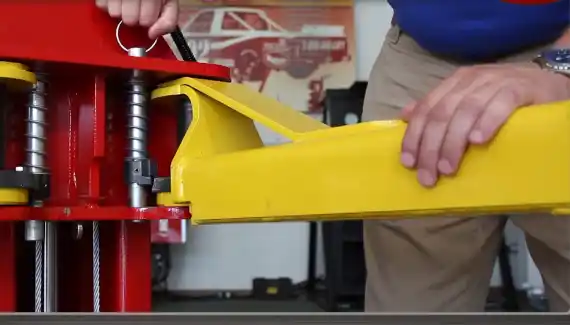
Properly inspecting and maintaining the vehicle lifts is essential for the safety of users, equipment, and vehicles. The following tips can help ensure your vehicle lift is always in optimal working condition:
Purchase a Certified Lift
When purchasing a lift, it’s important to ensure it meets all necessary safety standards and certifications. Look for certification from organizations such as OSHA and ANSI, which mandate certain lift design, construction, testing, operation, and maintenance requirements.
Utilize Qualified Inspectors
To ensure the lift’s safety and that its users, qualified inspectors who can detect any mistakes or defects in the lift’s design or construction should be utilized. Experience with similar lifts helps the inspector evaluate how well they are designed and built to meet industry standards.
The inspector should check all aspects of the lift, including its structural integrity, lifting capacity, emergency stops and controls, electrical components like wiring and switches, and lubrication systems.
Keep Written Documentation
It’s important to keep written records documenting all inspections performed on the vehicle lift so that any potential problems can be identified quickly with minimal disruption. It’s also helpful to keep detailed records regarding training sessions for operators concerning the proper use of lifting equipment.
Thoroughly Train Lift Operators
Training operators on the proper usage of lifts is essential for safety purposes. Qualified professionals should provide instruction on topics such as understanding load limits based on manufacturer weight capacity markings.
Furthermore, operators must understand what additional preventative measures must be taken when servicing heavier-than-average vehicles such as commercial trucks, etc.
Implement a Maintenance Program
A planned maintenance program ensures that your vehicle’s lift remains functional. This includes regularly inspecting mechanical components like chains/belts/cables/rollers/etc. Checking oil levels if needed and tightening bolts & nuts periodically as part of routine check-ups.
Do Daily Inspections
Daily inspections should be conducted before every shift, during which a vehicle lift is used to check functionality & performance. Furthermore, assessing operation controls (like buttons) & emergency stops located near base units is also recommended before any work begins.
What are the Consequences of Not Inspecting Vehicle Lifts on a Regular Basis?
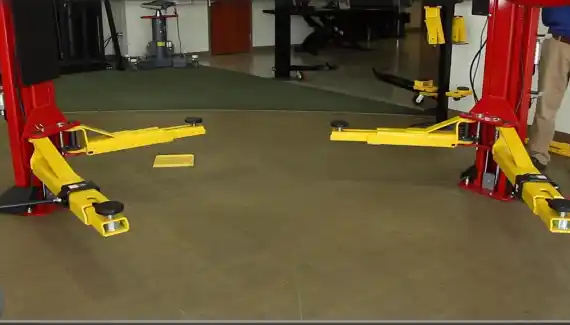
Regularly inspecting vehicle lifts is a critical safety measure for automotive professionals. If these inspections are not performed, the consequences can be dire.
Equipment Failure
Equipment failure can be hazardous and expensive, especially when dealing with large machinery such as vehicle lifts. Without regular inspections, problems can quickly develop without detection until they cause unexpected downtime and/or costly repairs.
The most common signs of equipment failure in vehicle lifts are loud noises during operation or an inability to properly move the platform into position. These issues should be addressed immediately upon detection to prevent further damage to the equipment.
Unwanted Accidents
Unwanted accidents are one of the most dangerous outcomes of not inspecting your vehicle lift regularly.
Suppose a piece of machinery is not working correctly or is malfunctioning. In that case, it could lead to catastrophic incidents or injuries that could have otherwise been prevented with regular maintenance and inspections.
The best way to mitigate this risk is by having certified technicians inspect the device consistently and make all necessary repairs as soon as possible.
Lost Productivity
Neglecting to inspect your vehicle lift can hurt productivity due to unexpected downtime or delays caused by malfunctions or breakdowns caused by lack of maintenance and care over time.
Lost productivity means missed opportunities which could eventually lead to financial losses should they become too frequent or severe enough to disrupt normal operations significantly.
Businesses need to stay proactive about their vehicle-lift inspections to avoid problems getting out of hand before they start impacting operations too deeply.
Costly Repairs
Finally, failing to inspect your vehicle lifts regularly may cost more money in the long run than if you had been proactive about maintenance in the first place.
This includes direct costs associated with expensive repairs and indirect expenses caused by lost productivity due to delays attributed to malfunctioning equipment or breakdowns due to a lack of regular inspection and upkeep.
Automotive professionals must understand that staying ahead on maintenance will save time, money, and potential disasters down the road compared to neglecting these important tasks entirely.
Keep Your Workplace Safe: Make Vehicle Lift Inspections a Priority!

In the end, vehicle owners and operators must know how important regular lift inspections are to maintain workplace safety. Inspections should be conducted at least once a year, with more frequent inspections required by the manufacturer for specific models.
Aside from that, it is essential to follow all other instructions from the manufacturer regarding lift usage, maintenance, and care to ensure its safe operation.
Not only that, but regular inspections help detect potential problems before they become costly repairs. With these simple inspections, vehicle lifts can remain in top condition for many years.
